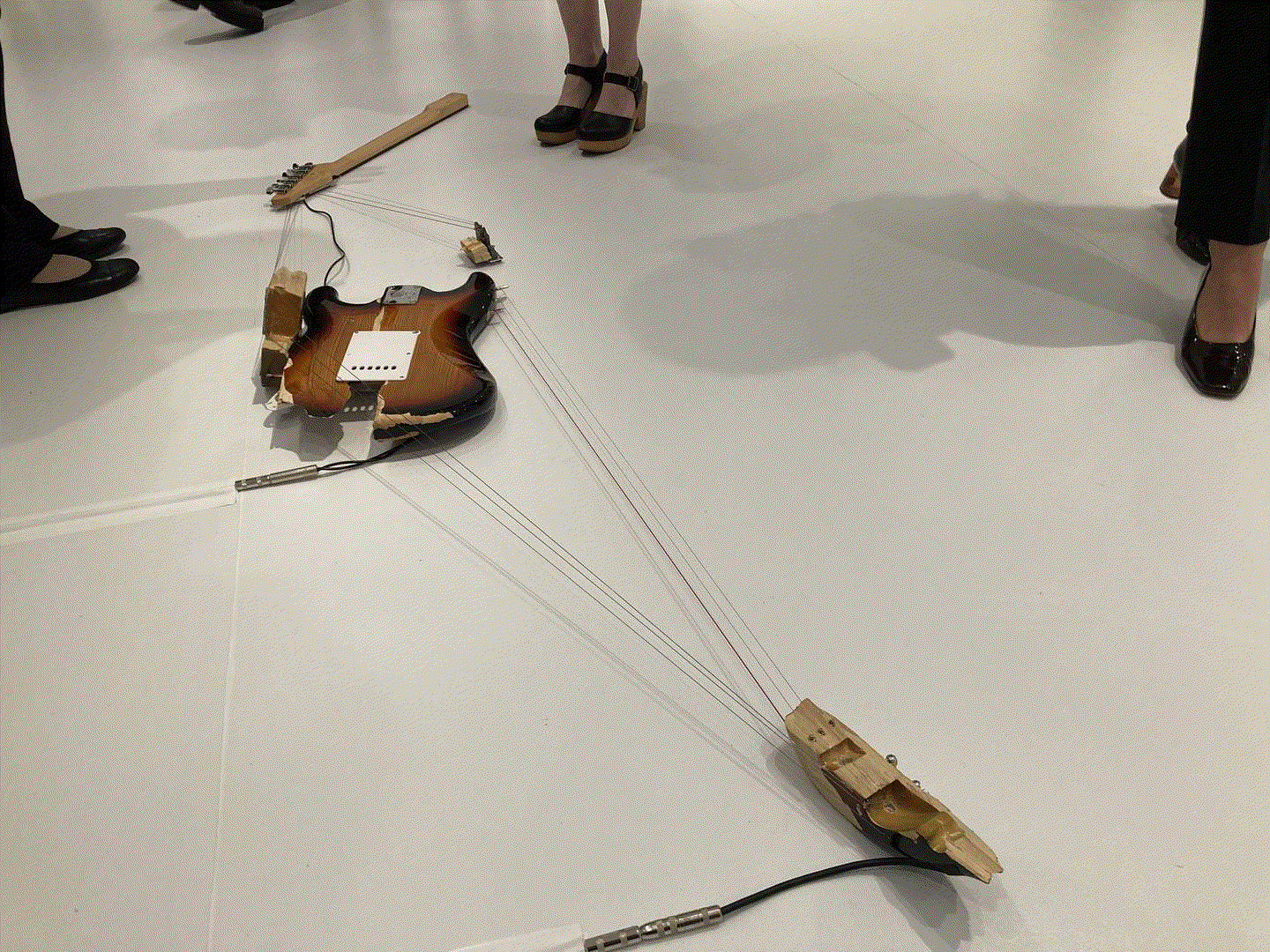
Shattered electric guitars litter the floor as part of the Atheneum’s latest Matrix gallery exhibit
The floor rocks, and you are the musician.
Naama Tsabar, the latest installation and performance artist to grace the Wadsworth Atheneum’s Matrix gallery, has smashed some electric guitars, then fastened the shards to the gallery floor. And you are invited to play them.
The artist, who was born in Israel and lives in New York, has been doing this, in various ways, since 2014. The Matrix exhibit is latest iteration of a larger connected piece and is therefore titled “Melodies of Certain Damage (Opus 6).”
Gallery visitors are allowed to bend down and pluck or strum the guitars, which are strung with guitar or piano wires (depending on how far gone the broken guitar is), tuned (to the notes in “Twinkle Twinkle Little Star,” more or less) and plugged into a PA system in the room. The strings aren’t contained by fretboards, existing almost independently of the shattered guitar bodies though still attached to the tuning pegs.
When “Melodies of Certain Damage (Opus 6)” nears the end of its more than four-month run in the Matrix space, the fragmented instruments will be professionally played in four free concerts, Sept. 10 and 11 at 2 and 4 p.m. Tsabar will be accompanied by Connecticut-based musicians who will compose original works during a series of rehearsals.

Museum patrons study a portion of Naama Tsabar's "Melodies of Certain Damage (Opus 6)," on the floor of the Matrix gallery at the Wadsworth Atheneum. (Christopher Arnott)
The Matrix space has been painted a stark white, but Tsabar wasn’t going for a clinical look. Rather she wanted sharp contrast between the artworks and their surroundings. She perceived “a landscape of debris,” she explained when attending the exhibit’s opening night June 3, and noted that not all her opuses have had white backgrounds.
“The work starts after the break,” she says, meaning the physical destruction of the guitars: “The place where rock and roll has left.” She visited the Wadsworth months ago to “optimize the place for the works to exist. It’s always in the mode of sculpting.”
She always takes new instruments, then destroys them: “I break the guitars I’ve always wanted to own.”
Fastening the fractured guitars to the floor has a purpose, Tsabar says.

Naama Tsabar talks at the opening of "Melodies of Certain Damage (Opus 6)." The guitars are on the floor are tuned and amplified and can be played by gallery visitors. (Christopher Arnott)
“When you play, you have to go down to the floor. For me, it’s an interesting place to think about the art. It’s so alive, so dynamic, that interaction.”
There is no clear invitation, no signs or notice boards, that explicitly invite viewers to bend down and play the smashed guitars.
“I don’t like to tell people what to do,” Tsabar says, and adds: “How daring are people, to touch the artwork?”
For the live performances, Tsabar specifies that her accompanists be local to the area where the museum is (in this case she’s likely reaching as far afield as New Haven, but within Connecticut) and are “female identifying or gender-nonconforming.” This furthers one of the main themes that inspired her work with electric guitars — confronting the male dominance associated with the instrument, which is often perceived as a phallic object.
A similarly themed video piece, “Untitled (Babies),” is screening in another area of the Wadsworth to augment the Matrix exhibit. “Untitled (Babies)” shows an all-female rock band, fronted by Tsabar, playing a cover of the pop song “Babies” by the ‘90s Brit pop band Pulp. The nature of the band puts a new perspective on the lyrics, originally sung by a male vocalist, Jarvis Cocker. The video ends with Tsabar smashing her guitar on the small platform stage the band is playing on, except that the guitar doesn’t break — surprisingly, the stage does. Tsabar continues to use the instrument as a sledgehammer until a large hole is formed in the wooden framework, as drums and feedback continue.
Tsabar says she is not a fan of The Who, the classic rock band generally associated with smashing guitars onstage, but says “definitely that’s the history of the object. The Who were art students who were familiar with Gustav Metzger and auto-destructive art.”

One of Naama Tsabar's creatively smashed floor-mounted guitars. (Christopher Arnott)
While she says she is “dealing with clichés” in such rock-based art, “my work never makes fun of things.” That includes the Pulp song, which was “a really big hit in Israel in the late ‘90s” by a band she respects. As her guitar-based work has progressed, she has grown away from using pre-existing music from other artists.
The live performances in the “Melodies of Certain Damage” series yield “original compositions which are community specific and place specific,” Tsabar says.
“Melodies of Certain Damage (Opus 6)” fits into a long Matrix gallery tradition of pop culture-based works as well as performance art. As part of an ongoing series of special events leading up to the Matrix’s 50th anniversary in 2025, Tsabar will appear in a Wadsworth-sponsored virtual conversation Aug. 4 at 6 p.m. with a previous Matrix artist, the renowned multimedia artist Laurie Anderson.
“Melodies of Certain Damage (Opus 6)” is in the Matrix gallery at the Wadworth Atheneum through Sept. 11. The free concerts will be Sept. 10 and 11 at 2 and 4 p.m. More information at thewadsworth.org

